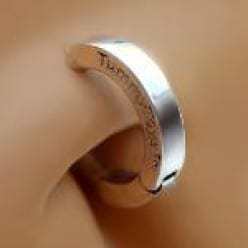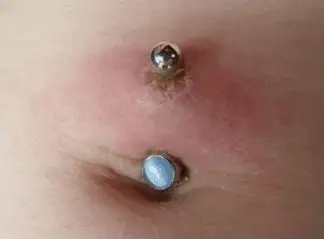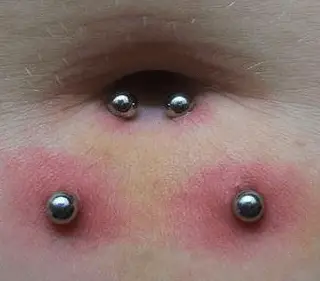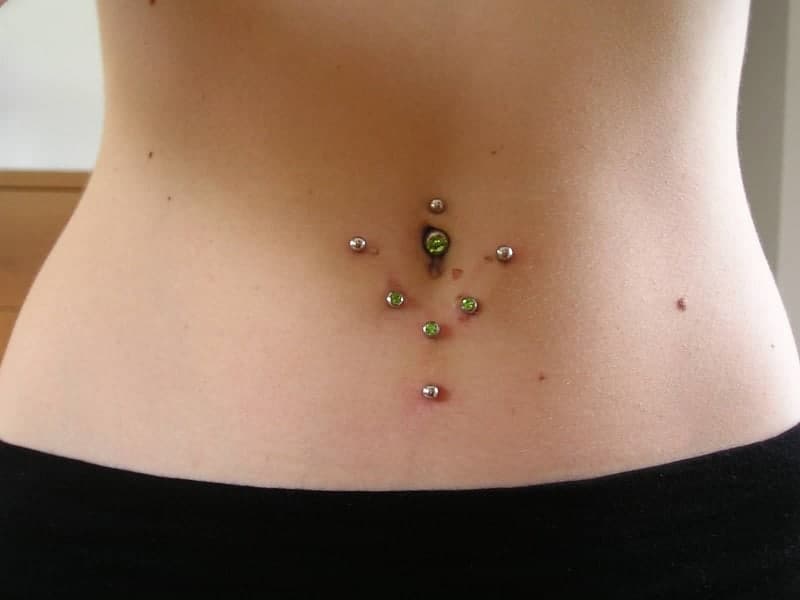Strictly following belly button piercing aftercare instructions is the best way to enhance an effective healing process. Furthermore, it prevents navel piercing infection and rejection. And, check this first before getting a belly button piercing.
You need to comprehensively understand belly button piercing aftercare once you have decided to go for one. Belly button piercing is among the most treasured type of body piercing that comes with heavy responsibility. There are high chances of navel piercing infection and long healing duration during the healing process if you don’t take good care of it.
* As an Amazon Associate I earn from qualifying purchases.
New Belly Button Piercing
Any new body piercing can be painful and hurting. It will take some time for your body to adjust, and pain will disappear once you do what is expected. It is quite normal during the first few days of new navel piercing to feel discomfort. Expect some discharge from the piercing, but that should not worry you since this is a fluid called lymph produced by the body to enhance healing.
During these initial days, it is normal to experience swelling, tenderness, and even soring. While the new navel piercing is healing, you will also recognize a few discolorations, itching, and yellowish fluid production that lead to the formation of crust around the barbell.
Everyone fears navel piercing infection or belly button rejection. Bacteria can invade the piercing and cause an infection. There are so many factors that can lead to such an invasion. Hygiene is very vital in the enhancement of any wound healing process. When you go to a professional navel piercer, some requirements will be recommended for your piercing.
Healing Process
There is always a navel piercing jewelry placed in the hole during the entire healing process. Some people will advise on maintaining the ring in place entirely, while others will ask you to move it. The best recommendation is to move the ring a little up and down to facilitate healing of both external and internal of the piercing.
During healing, you may find it hard to move jewelry up and down the hole freely. This is due to the normal tightening of cells and tissues around the ring as the healing process continues. After some time, the piercing may appear healed from the outside view, but in a real sense, it is not due to the slow healing of the internal tissues.
However, you need to be patient and persistent in adhering to the navel piercing aftercare instructions until you undergo complete healing. The ring has to remain intact since when you remove it, you are risking a navel piercing rejection, which can take place even after several years of healing.
There is what you should do and what you should not do regarding the belly button piercing aftercare. What to do involves the following:
- Always wash your hands using an antibacterial soap before touching the piercing.
- Wash the piercing at least twice a day using non-iodized sea salt solution and not table salt.
- Avoid bathing and swimming since bathtubs and pools contain bacteria.
- Taking a shower is highly recommendable. Avoid chemicals and creams directly to the piercing. Tanning lotions should not be in contact with it either.
- While cleaning, you can pour the sea salt solution or apply using a clean cotton ball.
- Gently move the ring slightly to enable the solution to reach the inside part of the holes.
- Remove the crust formed around the rind to enable the solution to get inside the piercing.
- Wear loose pants and tops since the piercing can get trapped in tight wearing.
- Always keep your clothes clean .
- Beddings and sleeping materials should always be washed to remain clean. This prevents chances of bacterial infections to the piercing. Blankets and bed sheets must be clean every time.
- Avoid sit-ups and press-ups can stretch the skin around the belly, causing pain until you heal completely. Conduct gentle exercises as you listen to your body.
- Do not overdo the cleaning or movement of the ring.
- Deeply Hydrates : The Botanic Hearth Tea Tree Hand Soap deeply hydrates and nourishes the hands with its active ingredients like Peppermint and Spearmint Oils, leaving hands refreshed
- Soothes Dry and Irritated Skin : The liquid hand soap is a gentle and soothing option for those facing skin irritations as tea tree is known for its abilities to fight and repair skin barriers and damage
- Cleanses All Impurities : The liquid handsoap deeply cleanses all dirt and bacteria without stripping the skin, leaving hands feeling clean and refreshed
- Smooth and Moisturized Hands : Tea Tree Liquid Soap by Botanic Hearth comes with moisturizing properties that help prevent dryness while also thoroughly cleansing the hands
- Ethically Sourced & Cruelty-free : Botanic Hearth products are made or packaged in the USA, cruelty-free, paraben-free, and not tested on animals
* As an Amazon Associate I earn from qualifying purchases.
- PIERCING CARE: THE BEST AFTERCARE DEAL ON AMAZON! Each jar makes 45 CUPS of Solution! TRUSTED & RECOMMENDED BY PIERCERS! "THE FINEST AFTERCARE AVAILABLE"! Urban ReLeaf PIERCING CARE -mix 1/4 teaspoon with 1 cup of warm water to make the ABSOLUTE BEST natural solution to heal your piercings! Medicated Sea Salt soaks are the best thing you can do for a new, stretched or angry piercing.
- "THIS STUFF IS AMAZING"! Healing Sea Salts are full of vitamins and minerals. Tea Tree Oil helps your body heal quickly! Aloe Vera and Vitamin E moisturize and nourish damaged skin. Works fast to heal the 'red and angry' feeling in new piercings.
- THE GOLD STANDARD FOR PIERCING AFTERCARE! Directions: Mix 1/4 teaspoon of salts in 1 cup warm water. Soak cotton ball with solution, Hold on piercing for 5 minutes, twice daily. This method works with your body's natural salinity to heal your piercings. Proudly MADE FRESH IN THE USA!
- "WORKS LIKE A MIRACLE"! Mixes up into the absolute BEST SOLUTION for your NEW, IRRITATED, RED & ANGRY piercings. Safely Clean & Heal by soaking just twice a day! You will be amazed at the quick healing powers of this 100% natural blend of non-iodized sea salts and essential oils. Feels incredible on piercings when you use WARM water!
- Mix a fresh batch every time! Each 3 oz. tub of PIERCING CARE will make 45 cups of Piercing Solution when mixed properly: 1/4 teaspoon to 1 cup (8 oz.) water. This is the BEST AFTERCARE DEAL ON AMAZON because that's a LOT of solution!
* As an Amazon Associate I earn from qualifying purchases.
Things to avoid during the healing period
As said, there are also things you should not do during the healing period. They include the following:
- Do not clean using chemical products such as Betadine, Hibiclens, alcohol, hydrogen peroxide, Dial, and other harsh soaps since they can irritate cells and tissue hence pain.
- Do not over clean. This can be irritating and hence interfere with the navel healing.
- Avoid subjecting the pierced area to friction, especially from tight clothes, vigorous washing, and tempering with the ring. This can be traumatizing and stressing of the tissues around hence migration and other complications.
- Avoid contact with body fluids to the new pierce from other individuals. This can cause infection due to bacterial transmission.
- Keep off using too many drugs such as caffeine, nicotine, and excessive drinking of alcohol during the healing process.
- Avoid swimming in the pools, lakes, and rivers during this period to prevent bacterial infections.
- Cosmetics and beauty products should not be let in contact with the new navel piercing since they can cause irritations and inflammation.
- Do not hang any other material to the jewelry, such as charm or beads. They can add weight that can result in navel piercing rejection and migration.
Cleaning Belly Button Piercing

Soap should not be used in the cleaning of belly button piercings. Neither should you use table salt solution for the wash. There are specific solutions for the cleaning of the wound. Using Piercing Aftercare Spray or Sea salt solution is highly recommended for washing a new navel piercing. Cleaning should be regular but not overdone . 2 to 3 times a day is enough.
While cleaning, move the jewelry gently up and down to enable the sea salt solution to get into the hole. Healing should take place both internally and externally. A professional piercer should be consulted should you have to change the jewelry due to unavoidable circumstances.
- FIRST EVER PIERCING AFTERCARE - Our natural sea salt saline tattoo and piercing healing spray was the first piercing aftercare product ever created, this patented formula has healed millions of tattoos since 2001.
- FAST ACTING - This natural sea salt saline spray calms tissues, and reduces pain and inflammation allowing piercings and other wounds to heal extremely fast.
- NATURAL ENZYMES - Contains an enzyme called lysozyme, which is found in your own tears and saliva that helps your body to speed up the healing process.
- SEA SALT NOT TABLE SALT - Nutrient rich sea salt from the Red Sea is a key ingredient in H2Ocean products, others use saline table salt, but H2Ocean’s patented sea salt solutions contain over 82 trace minerals that are essential for healing.
- THE ORIGINAL ONE - H2Ocean has been committed to producing all natural sea salt based tattoo and piercing aftercare products that are 100% guaranteed to satisfy since 2001, all made in the USA.
* As an Amazon Associate I earn from qualifying purchases.
Belly Button Piercing Pain
When your belly button is pierced, you are likely to feel some pain for a few seconds. Individuals have a different degree of pain tolerance. Some will feel more pain while others not. Navel piercing pain disappears once the process is done and may reappear again slightly during the first few days of healing. It will, however, disappear again when you correctly follow the navel piercing aftercare instructions discussed above.
During healing, highly extreme pain can imply that something is wrong. When associated with other symptoms such as soaring and discoloration, it can imply an infection or a rejection. This is the time you need to listen more to yourself and intensify on the aftercare instructions.
Belly Button Piercing Healing
If you strictly follow that navel piercing aftercare advice, regardless of the types of navel piercing, it will take a short time for healing to be complete. 9 to 14 months is the recommended time for a complete healing process. Beware that rejection can still take place even after healing. It depends on your body’s reaction to foreign materials.
You can change your navel jewelry once the piercing has successfully healed. A professional piercer should also do this to avoid any complications. Select the right metal that is not allergic to your body while changing for a piece of different navel jewelry.
Some things are perceived as normal to do with a new navel piercing. Pain is no longer the major worry about belly button piercing. Depending on an individual’s degree of pain tolerance, the piercing process is not as seriously painful as many people imagine. The process takes a few seconds to be carried out on the skin around the actual belly button.
Once done, there is the possibility of soreness and slight pain during the piercing’s initial days. Expect some yellowish discharge. It simply the production of lymph, a normal thing in any newly wounded part of the body. It helps in cleaning and washing out any possibility of bacteria in the wounded area.
During the healing process, there is a possibility of an infection caused by various factors. To begin with, poor hygiene conditions are the major causes of navel piercing infections. Touching your newly pierced navel with contaminated hands can lead to germs and bacterial infections. Contact of the piercing with body fluids from another individual.
The kind of wearing and bedding you use can also cause infection, especially if they are not properly cleaned and disinfected. When your new navel piercing gets infected, you may not easily tell unless you make close observations.
There are various signs of infected navel piercing that should alert you that something is wrong. They include the following:
- There are constant navel piercing soreness and high skin sensitivity that can be irritated by the touch of a shirt or blouse.
- You can see with your eyes the navel piercing jewelry through the skin due to the reducing thickness.
- The navel piercing ring or bars will hang more loosely compared to when it got placed.
- The navel holes size around the piercing increase in size, and you can see them becoming larger.
- There is an increase in the amount of discharge from the navel piercing holes.
- Formation of navel piercing keloid.
- Constant pain, especially when touched by anything.
- Inflammation and irritation due to over sensitivity.
- Redness and more colored discharge from the piercing holes.
- Swelling of the belly button piercing.

During the navel piercing healing process, it is good to become responsible. When you look at navel piercing aftercare tips, some dos and don’ts can help you successfully go through the healing process.
Depending on an individual’s body reaction to foreign material, navel piercing rejection can also occur, though it is rare. Initial signs and symptoms of rejection are the same as those associated with an infection. The main difference is that migration can occur even after healing, while the infection is mostly during the healing period.
It takes 9 to 12 months for healing for complete healing. When you realize any abnormality, it is good to check and advance on your caring level. There are some cosmetic products such as soap, creams, and lotions that can cause the infection. It is recommended to avoid any contact with the area with skincare products.
Cleaning process
A shower is the only recommended way of washing your body. This is based on findings that bathtubs have high levels of accumulating and sustaining bacteria. The number of times you clean your belly button piercing can also determine the wellbeing of the piercing.
Soaps should not directly be used in the cleaning of the pierced area. Neither should you use table salt as people often get confused with it. Clean the piercing twice or thrice a day using a sea salt solution. Sea salt soaks help in the killing of bacterial as well as promoting faster healing.
- PIERCING CARE: THE BEST AFTERCARE DEAL ON AMAZON! Each jar makes 45 CUPS of Solution! TRUSTED & RECOMMENDED BY PIERCERS! "THE FINEST AFTERCARE AVAILABLE"! Urban ReLeaf PIERCING CARE -mix 1/4 teaspoon with 1 cup of warm water to make the ABSOLUTE BEST natural solution to heal your piercings! Medicated Sea Salt soaks are the best thing you can do for a new, stretched or angry piercing.
- "THIS STUFF IS AMAZING"! Healing Sea Salts are full of vitamins and minerals. Tea Tree Oil helps your body heal quickly! Aloe Vera and Vitamin E moisturize and nourish damaged skin. Works fast to heal the 'red and angry' feeling in new piercings.
- THE GOLD STANDARD FOR PIERCING AFTERCARE! Directions: Mix 1/4 teaspoon of salts in 1 cup warm water. Soak cotton ball with solution, Hold on piercing for 5 minutes, twice daily. This method works with your body's natural salinity to heal your piercings. Proudly MADE FRESH IN THE USA!
- "WORKS LIKE A MIRACLE"! Mixes up into the absolute BEST SOLUTION for your NEW, IRRITATED, RED & ANGRY piercings. Safely Clean & Heal by soaking just twice a day! You will be amazed at the quick healing powers of this 100% natural blend of non-iodized sea salts and essential oils. Feels incredible on piercings when you use WARM water!
- Mix a fresh batch every time! Each 3 oz. tub of PIERCING CARE will make 45 cups of Piercing Solution when mixed properly: 1/4 teaspoon to 1 cup (8 oz.) water. This is the BEST AFTERCARE DEAL ON AMAZON because that's a LOT of solution!
* As an Amazon Associate I earn from qualifying purchases.
Diet
A nutritional diet can also increase the rate of healing. Take food rich in vitamins, iron, and proteins. Depending on your type of navel piercing, this is also one way of boosting your body immunity to fight against any infection.
Migration occurs when the body does not recognize any foreign material and begins acting to push it out. For this case, the navel piercing jewelry can be rejected by the body. Proper care of your piercing can also prevent chances of migration or rejection.
Knowing how to clean a navel piercing is the best way to prevent and treat any belly button piercing infection. Infected navel piercing can become chronic if not properly addressed. Navel piercing rejection and scaring can easily follow.
The use of sea salt solution is the cheapest and most convenient way of ensuring a clean belly button piercing. Over the counter, antibacterial drugs are also available in pharmaceutical centers, effective for treating an infected navel piercing.
Your tops and pants should be clean and ushered. Regularly change your beddings, especially the bedsheets. Antibacterial soap should be used in the washing of hands before touching the belly button area. When symptoms and signs persist, seek medical consultation from your doctor and advice from a professional piercer.

Swelling is a sign of both a rejection and an infection. Though it is quite normal for a new navel piercing to swell during the initial days. It is expected to heal and subside after a thorough cleaning with the correct solutions. An infection can cause a swollen navel piercing, and you can notice when it is associated with other signs and symptoms such as inflammation and soreness.
A swollen navel piercing can also be painful. For migration, the swelling can occur even after the healing process is complete. Check with your piercer for advice if you notice rejection since little you can do on your own about it.
Changing the navel piercing jewelry can prevent and stop the rejection and should be done by a professional piercer.
Sometimes the barbell ring metal material used can cause swelling. However, a different metal can be used upon changing the originally used one. Proper aftercare is also the best way to prevent and stop any further swelling.




